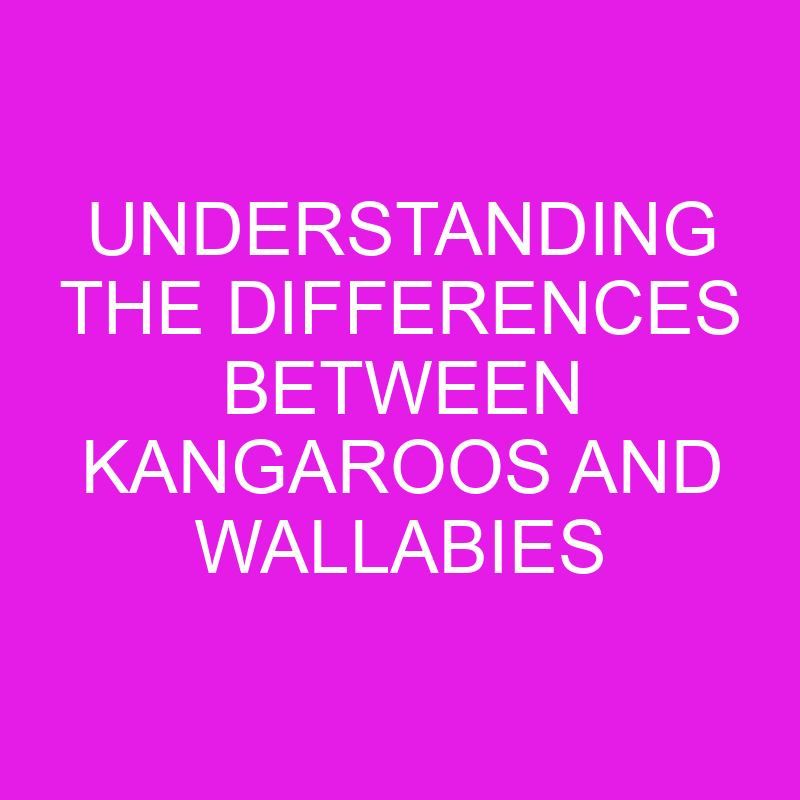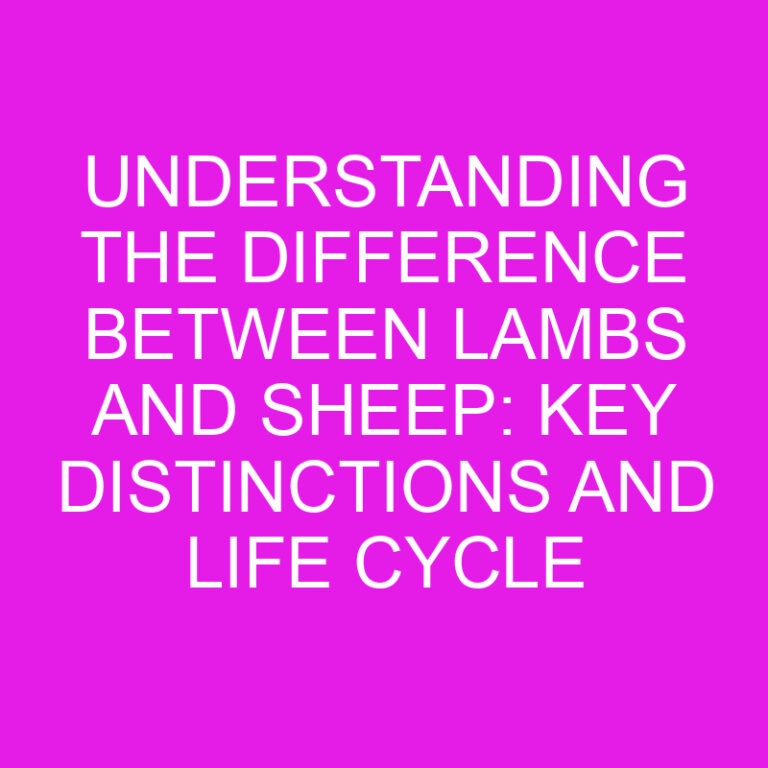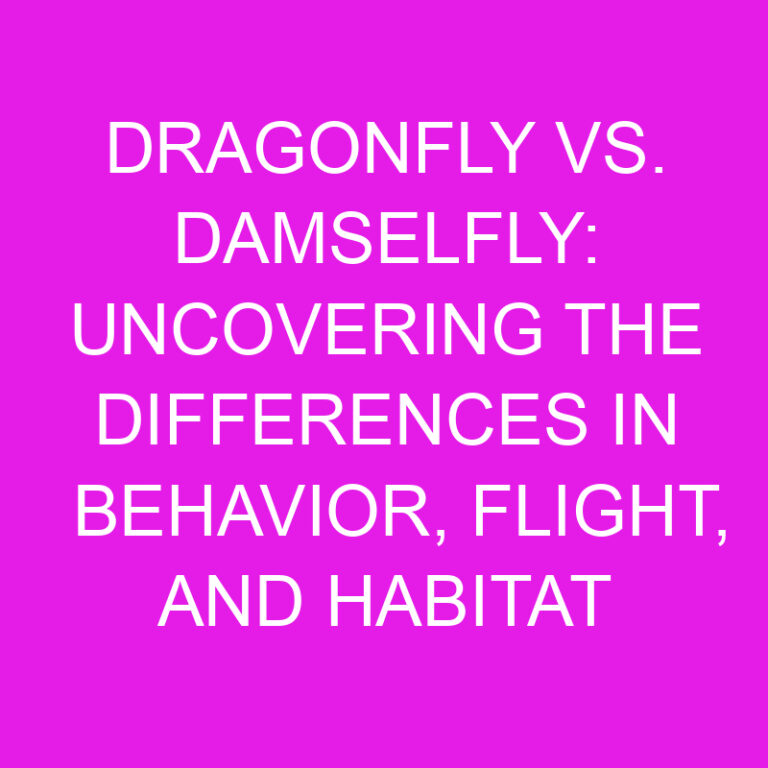
Kangaroos and wallabies are fascinating creatures that are native to Australia. While they may look similar at first glance, there are some key differences between the two. In this article, I’ll be exploring the distinctions that set kangaroos and wallabies apart, shedding light on their unique characteristics and behaviors.
Firstly, let’s talk about size. Kangaroos are generally larger than wallabies, with the largest kangaroo species reaching heights of up to 6 feet and weighing over 200 pounds. On the other hand, wallabies are smaller and more compact, with the largest species typically measuring around 3 feet tall and weighing around 50 pounds.
Another noticeable difference lies in their habitats and behavior. Kangaroos are known for their ability to hop long distances and are typically found in open grasslands and woodlands. Wallabies, on the other hand, are more adaptable and can be found in a variety of habitats, including forests, shrublands, and even rocky areas.
While kangaroos and wallabies may share some similarities, such as their pouches and hopping abilities, there are distinct differences in their size, habitat preferences, and behavior. Understanding these differences can help us appreciate the unique qualities of these incredible marsupials.
Post Contents
Size Differences
When it comes to size, there are clear distinctions between kangaroos and wallabies. Let’s dive into the details:
Kangaroos:
- Kangaroos are the larger of the two marsupials, with some species reaching heights of up to 6 feet (1.8 meters).
- They are known for their impressive muscular build, with adult males weighing anywhere between 120 to 200 pounds (55 to 90 kilograms).
- Female kangaroos, known as does or jills, are generally smaller and lighter than the males, weighing around 65 to 90 pounds (29 to 40 kilograms).
- Wallabies, on the other hand, are more compact and smaller in size compared to kangaroos.
- They typically range in height from 1 to 3 feet (0.3 to 0.9 meters).
- The weight of adult wallabies can vary depending on the species, but they generally weigh between 15 to 40 pounds (7 to 18 kilograms).
It’s fascinating to see the contrast in sizes between kangaroos and wallabies. The impressive stature of the kangaroo allows it to dominate its environment, while wallabies excel in their agility and adaptability, thanks to their smaller size. Understanding these size differences between kangaroos and wallabies adds to our appreciation of their unique qualities.
Habitat and Behavior
Kangaroos and wallabies have different habitat preferences and behavior patterns. Understanding these differences can provide further insights into these fascinating creatures.
Habitat:
- Kangaroos primarily inhabit open grasslands, woodlands, and scrublands in Australia. They are well-adapted to the arid and semi-arid regions of the country.
- Wallabies, on the other hand, have a broader range of habitats. They can be found in various landscapes such as forests, coastal areas, and mountainous regions. Some species even inhabit rainforests.
Behavior:
- Kangaroos are known for their unique hopping locomotion, using their powerful hind legs as springs. Their large size allows them to cover long distances in search of food and water.
- Wallabies are more agile and nimble, utilizing a combination of hopping and bounding movements. They can navigate through dense vegetation and rocky terrains with relative ease.
- Kangaroos are primarily herbivores, feeding on grass, leaves, and shrubs. They have the ability to survive in harsh environments with limited food resources.
- Wallabies have a more varied diet, which includes grass, fruits, leaves, and even bark. This versatility allows them to adapt to different habitats and food availability.
Social Structure:
- Kangaroos are generally more social, forming groups called mobs. These mobs can range from a few individuals to larger gatherings of up to several dozen kangaroos.
- Wallabies are more solitary in nature, although some species may form small groups or pairs. They prefer a relatively independent lifestyle, exploring their surroundings on their own.
- Kangaroos have a complex reproductive system. Females have the ability to delay the development of their embryos until they are ready to give birth. This process is known as embryonic diapause.
- Wallabies have a similar reproductive system to kangaroos, but some species have a shorter gestation period and can reproduce at a younger age.
Understanding the habitat preferences, behavior patterns, social structures, and reproductive characteristics of kangaroos and wallabies enhances our appreciation for the diverse and amazing world of marsupials.
Similarities and Differences
When it comes to comparing kangaroos and wallabies, there are both similarities and differences to consider. Let’s take a closer look at these fascinating marsupials.
Habitat
While both kangaroos and wallabies are native to Australia, they can be found in different types of habitats. Kangaroos are primarily found in open grasslands, woodlands, and scrublands, whereas wallabies have a broader range of habitats including forests, coastal areas, and mountainous regions. This difference in habitat allows wallabies to adapt and thrive in various environments.
Behavior
In terms of behavior, kangaroos and wallabies have distinct characteristics. Kangaroos are known for their unique form of locomotion – hopping. This method of movement allows them to cover large distances efficiently. On the other hand, wallabies are more agile and nimble, making them adept at navigating through dense vegetation and rocky terrain.
Social Structure
Socially, kangaroos and wallabies have different lifestyles. Kangaroos are generally more social animals, forming groups called mobs. These mobs can consist of a few individuals or dozens, depending on the species. Wallabies, on the other hand, are more solitary creatures, preferring to live and forage alone or in small family groups. This difference in social structure reflects their individualistic and communal tendencies.
Reproductive Characteristics
Another interesting difference between kangaroos and wallabies lies in their reproductive characteristics. Kangaroos have a fascinating reproductive system, where females have the ability to delay the development of their embryos. This unique adaptation allows them to prolong the gestation period when resources are scarce. On the other hand, wallabies also have a similar reproductive system, but some species have a shorter gestation period compared to kangaroos. This difference in gestation period reflects their ability to adapt to their specific environments.
Understanding the similarities and differences between kangaroos and wallabies not only enhances our knowledge of these remarkable creatures but also highlights their incredible adaptations to different habitats, behavior patterns, social structures, and reproductive strategies. These marsupials truly exemplify the diversity and wonder of nature.
Unique Qualities
Let’s take a closer look at some of the unique qualities that distinguish kangaroos and wallabies:
- Adaptations for Hopping: One of the most distinctive features of kangaroos is their incredible ability to hop. This specialized mode of locomotion allows them to cover large distances efficiently, reaching speeds of up to 40 miles per hour. Kangaroos have long and powerful hind legs, which enable them to take long leaps, while their muscular tail acts as a balance and propels them forward. Wallabies, on the other hand, have a more agile and nimble movement, which allows them to navigate through dense vegetation and rocky terrains with ease.
- Behavior and Social Structure: Kangaroos are highly social animals that form groups called mobs. These mobs consist of both males and females, led by a dominant male known as the alpha male. Within the mob, there is a hierarchical structure, with dominant individuals having priority access to resources and mates. Kangaroos communicate through a variety of vocalizations, body postures, and tail movements.
Wallabies, on the other hand, tend to be more solitary in nature. They prefer a more secluded lifestyle and are often found grazing alone or in smaller groups. While they may occasionally come together for mating purposes, wallabies generally maintain a more independent existence.
- Reproductive Strategies: Kangaroos have a unique reproductive system that allows females to regulate their pregnancies. They have the ability to delay the development of their embryos until favorable conditions for raising young are present. This physiological adaptation, known as embryonic diapause, ensures that their offspring have a better chance of survival. Kangaroos also have a relatively long gestation period, averaging around 30 to 36 days, depending on the species.
Wallabies have a similar reproductive system to kangaroos, but some species have a shorter gestation period, ranging from 26 to 38 days. This shorter gestation period allows them to produce young more frequently, increasing their chances of successful reproduction in environments with unpredictable conditions.
Conclusion
Kangaroos and wallabies are fascinating marsupials that share similarities but also have distinct differences. Kangaroos primarily inhabit open grasslands, woodlands, and scrublands, while wallabies have a broader range of habitats including forests, coastal areas, and mountainous regions. Kangaroos are known for their unique hopping locomotion, while wallabies are more agile and nimble, allowing them to navigate through dense vegetation and rocky terrains.
In terms of social structure, kangaroos are highly social animals that form groups called mobs, led by a dominant male. On the other hand, wallabies tend to be more solitary and prefer a more secluded lifestyle.
Reproductively, kangaroos have a complex system where females can delay the development of their embryos until favorable conditions for raising young are present. Wallabies have a similar reproductive system, but some species have a shorter gestation period.
Understanding the differences between kangaroos and wallabies not only enhances our knowledge of these unique creatures but also highlights the diverse adaptations and behaviors that have allowed them to thrive in their respective habitats.
Frequently Asked Questions
Q: What are the differences between kangaroos and wallabies?
A: Kangaroos primarily inhabit open grasslands, woodlands, and scrublands in Australia, while wallabies have a broader range of habitats including forests, coastal areas, and mountainous regions. Kangaroos have a unique hopping locomotion, while wallabies are more agile and nimble. Kangaroos are more social, forming groups called mobs, while wallabies are more solitary. They also have differences in their reproductive characteristics, with kangaroos having a complex system of embryo development delay, while wallabies have a shorter gestation period.
Q: What are the unique qualities of kangaroos and wallabies?
A: Kangaroos have adaptations for hopping, with long and powerful hind legs and a muscular tail that acts as a balance. Wallabies have a more agile and nimble movement, allowing them to navigate through dense vegetation and rocky terrains. In terms of behavior and social structure, kangaroos are highly social animals that form groups called mobs, led by a dominant male. Wallabies, on the other hand, tend to be more solitary and prefer a more secluded lifestyle. Both kangaroos and wallabies have unique reproductive systems, with kangaroos having the ability to delay embryo development and wallabies having a shorter gestation period.






